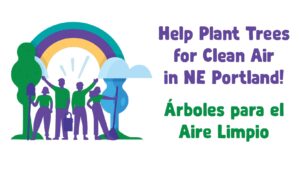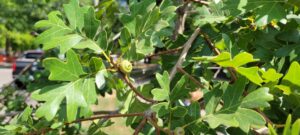Category: Neighborhood Trees
Clean Air Canopy
Trees for Clean Air in NE Portland
If you live in Sumner, Cully, Parkrose, Argay, or Wilkes, register here to get a free tree!
Of all the benefits that trees provide, clean air is one that entire communities benefit from. When the Owens-Brockway glass facility was found to be excessively polluting in the vicinity of several Northeast Portland communities and the Columbia Slough Watershed, the Oregon Department of Environmental Quality fined the facility and granted funds to Friends of Trees and our partners to lead community tree plantings in the area.
Friends of Trees, in partnership with community members and organizations, will coordinate the planting of 5,000 native plants and trees over the course of the Clean Air Canopy project.
Of these, about 800 trees will be located along neighborhood streets and private properties in the Sumner, Cully, Parkrose, Argay, and Wilkes neighborhoods. 4,200 more native plants and trees will be planted in natural areas located across these neighborhoods and along the Columbia Slough watershed.
This project would not be possible without our partners: Verde, the Cully Air Action Team (CAAT), and the Cully Association of Neighbors. Verde and CAAT’s advocacy work held this polluter accountable and led to this project’s creation. These partners have been instrumental to our outreach efforts.
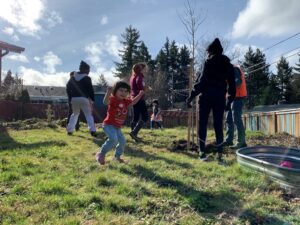
“This project really represents the breadth of what we do at Friends of Trees,” says Green Space Program Manager Michelle Yasutake. “Working in both neighborhoods and natural areas, connecting with community members, and providing a tangible benefit in the form of cleaner air.”
These new trees and native plants will improve air quality and the quality of life for residents of these NE Portland neighborhoods. Leaves from the trees planted in this project will not only intercept and store particulate matter from the air, they will provide shade and cooling benefits, lessen urban heat island effects, and improve habitat and stormwater management.

Friends of Trees is already working with community members to identify planting locations. Planting and caring for the trees together gives us a chance to talk with the community about the positive impacts of clean air, clean water, and healthy urban tree canopy in neighborhoods and nearby industrialized areas.
“We’re really excited for this opportunity to form connections with residents, and to work alongside them to understand their needs and bring trees to their community in a way that works best for them,” says Aliesje King, the Neighborhood Trees Program Manager at Friends of Trees.
If you live in Sumner, Cully, Parkrose, Argay, or Wilkes, reach out to us to get a free tree! Register here, or email us at [email protected] with any questions.
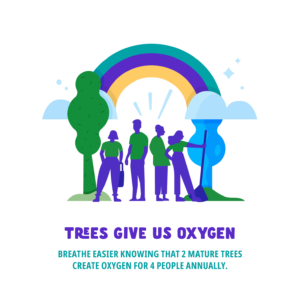
Our End of Season Shade Tree Sale is Here!

Complete your garden project today by adding one of our trees to your yard! We order our trees locally from wholesale nurseries, among the best in the US. The weather is warming, and flowers and trees are beginning their annual spring bloom. The time is now to get some new trees in the ground before summer rolls around.
On Saturday, May 14, 10am- 1pm, the Shade Tree Sale will be held at our office in NE Portland, (map). The sale includes sliding scale pricing: $5-75.
Need Street Trees? We got you! Our trees are large stock trees and might fit the requirements for replacing a street tree, or adding a street tree to your front or side planting strip or right-of-way (A planting permit is required to plant in the right-of-way. Apply for free here).
Here is a link to the urban forestry street tree list.
Looking for a yard tree to help increase the urban canopy or complete a garden project? We have some great options for you as well.
How it works: Arrive to Friends of Trees headquarters on Saturday, May 14th between 10:00 am-1:00 pm, take a look around, and consult with Friends of Trees staff. If you find a tree for you, you can purchase the tree and take it home that day (these trees are tall, so you’ll need to bring a vehicle with space, or you can arrange to pick up the tree the following week).
If you’re interested, email us at [email protected] and we’ll send you more information.
Trees Through The Years
Our inspection program connects volunteers to specific trees, visit after visit.
When Friends of Trees plants a tree, we don’t just wash the dirt off of our hands and move onto the next one. We return to inspect it, to prune it, replenish mulch, and make sure everything is looking good. These check-ups are for more than just to care for that individual tree—we’re also collecting data.
Most of the data that we track is for younger trees, Tiers 1, 2, and 3, according to their age, Tier 1 being trees that were planted in the most recent season. We do this to make sure each tree was planted properly, to track the survival rates of different species, assess the quality of the nursery stock, and keep an eye out for any trends we need to adapt to.
“We also do this to provide tree care advice to the tree recipient,” Haley says. If a tree fails for reasons beyond neglect, we can replace the tree or refund the recipient.
There’s another set of much older trees that we have been collecting data on: Tier Omega. Tier Omega trees were planted in the 2010 season, and we’ve been checking on a subset of them, the same exact subset, every year since they were planted. This has created a consistent and robust data set that can show the long term survival rates of older plantings.
In the summer of 2010, 486 Tier Omega trees were planted. Since then, just 45 trees from the Tier Omega subset have died or were moved due to development reasons. Now that these trees have settled, they’re less likely to be dramatically impacted by weather, so we have been seeing fewer dead trees with each round of inspections.
“There’s this great community feel to it,” Neighborhood Trees Senior Specialist Haley Miller says about the inspection program. “We have some Tier Omega inspectors who have been inspecting the same exact trees for eleven years now.”
Mike Ablutz is one of those Tier Omega inspectors who just keeps coming back. “Revisiting the same trees over several years is like checking in with young friends,” he says. “I love seeing how they are doing, how fast they are growing, and discovering the many ways that they are adapting to life’s challenges.”
When people sign up to get a tree from Friends of Trees, they can volunteer to be tree inspectors. They are assigned a Tier 1 route of about twenty trees, including their own, that need to be inspected twice each summer. Inspectors monitor things like weeds, mulch, and water. They measure the size of the tree and look for things like bark damage. “It’s a popular volunteer role,” Haley says. “People really enjoy visiting their trees.”
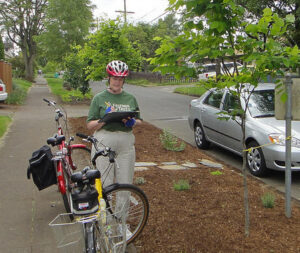
The tree inspection process is also one of the ways we engage our youth education programming at Friends of Trees. Our partnerships with the Portland Opportunities Industrialization Center and the Blueprint Foundation connect students and young people to urban forestry work. In the summer, they get to help with tree inspection, which continues to develop forestry skills like tree identification, and grow their connections to nature.
We are learning more and more that when a person feels a connection to a particular tree, it grows their connection to trees and nature more broadly. Our tree inspectors are proof of that.
“I often imagine how the young trees we plant will look when they are old,” Mike says. “Tier Omega inspections allow me to revisit specific trees and at least see how they are doing in their early years.” Hopefully Mike will get the chance to keep revisiting those trees for years to come.
Trees are part of the solution to climate chaos
A letter from executive director Yashar Vasef, with an update about community tree planting in Portland
Friends,
It’s official: We need trees more than ever. Heatwaves, flooding, and all of the increasingly catastrophic effects of climate change make it clear that every day needs to be the day for climate action. Friends of Trees has been planting trees in neighborhoods and natural areas for 32 years; we’re planting street and yard trees that will shade our streets and cool our homes, prioritizing low-canopy, underserved neighborhoods, and we’re also planting native trees and shrubs to help restore sensitive natural areas.
Since 1989 we’ve planted more than 870,000 trees and native shrubs, and we’ve done this through engaging tens of thousands of community members, and while implementing and growing programming that aims to do this work inclusively and equitably.
“At a time when climate change is making heat waves more frequent and more severe, trees are stationary superheroes.” (New York Times, 7/2/2021)
It’s not enough. We are experiencing climate chaos, and trees are increasingly promoted as a major solution, which is why you may have seen Friends of Trees in the news recently. Some of that news focused on our 13 year partnership with the City of Portland Bureau of Environmental Services.
It seemed until recently that funding for our work planting and caring for street and yard trees in Portland was ending, and our concern was that with our funding ending, and without funding being awarded to anyone for community tree planting, this critical work would be suspended for an unknown amount of time. And given climate change’s growing severity, we simply cannot afford to even temporarily pause community tree planting.
It is widely acknowledged that planting trees is a key part of a comprehensive climate strategy. It is our experience at Friends of Trees that planting trees with community members is also key to fighting climate change.
Planting and caring for trees increases community members’ engagement with the environment and overall participation in civic life, including engaging around climate action. There is a ripple effect from volunteering to plant trees that also fights climate change, beyond the actual trees. We expect to have quantitative data supporting this from the research we are conducting through our community grant from the Robert Wood Johnson Foundation, look for an update this winter.
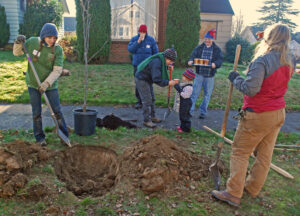
We have since learned that we will receive gap funding to partially continue our Portland tree planting and care efforts through spring 2022, and our deepest thanks go to BES, and also to Commissioner Mingus Mapps’ office, which played a critical role in this positive development. However, there are some significant changes that if implemented would drastically change community tree planting in the City of Portland. As details firm up we will continue to keep you updated.
This particular contract is so important because so much of it has funded planting street trees. Trees play an invaluable role in combating heat islands brought on by climate change, and street trees especially so. Streets and concrete sidewalks absorb and retain heat, and release it at night; street trees help fight this effect and are crucial to cooling neighborhoods.
By now most of us are aware of the inequities with Portland’s tree canopy, one result of which is more heat islands in low-canopy/low-income/under-served neighborhoods. Friends of Trees prioritizes these neighborhoods and will continue to advocate for partnerships and practices that plant trees where they are needed most.
Looking past this upcoming season, BES has said they will issue a new RFP (Request For Proposals) for this sort of work–community tree planting and tree care–sometime this fall/winter, and our understanding is that, while they acknowledge the success of our partnership, they would like to engage other, diverse community partners. And to that we say, Yes!
We fully support BES taking on a new approach to their contracts in a way that prioritizes smaller and BIPOC organizations. It is our belief that uplifting such organizations in this work will make our mission stronger and brings all of us closer to climate justice by introducing voices at the table which were previously shut out. This is why Friends of Trees, during the evolution of our 13 year partnership with BES, has entered into partnerships in this work with organizations such as APANO, Blueprint Foundation, POIC, Verde, Wisdom of the Elders, and others.

Yes, BES (and all other public and private funders) should absolutely fund more community organizations in the fight against climate change and toward climate justice, and we fully support an open RFP process. As more funders work to diversify their support of community organizations, we encourage an approach that increases the funding pie (as in, make a bigger pie as opposed to cutting smaller slices) so more partners can be included. The planet is literally on fire and NOW is the time to increase investments in climate change.
Now we really have some work to do. We are preparing for the next planting season, and we’re doing so with significantly decreased funding and options for our largest urban tree planting site, the City of Portland. In October, when we kick off our 33rd season of planting and caring for trees as a community, we’ll be coming to you to ask that you support this work like never before, since this will be a season like never before.
A global pandemic, climate change, social injustice and political strife present our community with unprecedented challenges and often devastating impacts. As we all work together to re-envision our future, a future that is green, healthy, equitable and inclusive, we must ask all our policy makers and leaders where do their values lie. And do their budgets address an urgent climate crisis unlike anything humanity has experienced? For the sake of our communities, our natural habitats, climate refugees, wildlife, and the pale blue dot we call home, together, let’s ensure they are up to the task.
All my best,

Yashar Vasef, Executive Director
Photo, top: Gambel oak tree
Growing fruit trees is a rewarding hobby
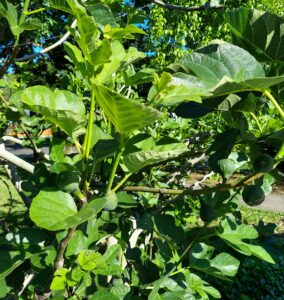
“I love being able to go outside and grab a fresh piece of fruit for a snack – it’s healthy, seasonal, organic, and free.”
-Andrew Land (he/him), Neighborhood Trees Senior Specialist and home orchardist
Home orchardry is a rewarding hobby. Growing and maintaining fruit trees keeps you active, gets you outside, and provides fresh food. Fruit trees are also great trees for small spaces where larger trees just won’t work. Friends of Trees plants about 400 fruit trees every season, and they are an increasingly popular choice for yard trees.
Fruit trees are also a lifestyle—it’s a healthy one, but also one that requires regular, active involvement. As Andrew emphasizes, “Fruit trees are high maintenance. Growing fruit trees is a great lifestyle, but it’s not for everybody.”
Fruit trees require annual pruning, and they are pruned very differently than other trees. They also require extra attention: Home orchardists need to be on the lookout for pests & disease.
Location, location, location! Where fruit trees are planted makes a difference, particularly in terms of sun exposure for species susceptible to fungal disease. For instance, it’s ideal to plant fruit trees that are prone to fungal disease (e.g., European pear, some plum, some apple trees) in a location that gets early morning sun so that overnight dew on leaves has a chance to dry, thus offering some protection from fungal disease.
Friends of Trees works to source pest & disease resistant varieties, and provides all new fruit tree recipients with tree care information specific to fruit trees. However, it’s important to keep in mind that all fruit trees will always require extra monitoring and care (and resistance does not = immunity).
Still interested in growing fresh fruit in your own backyard?
In a typical season our top two recommended fruit trees are fig and persimmon. Why? Essentially they are the most pest & disease-free, they require less water, and they are generally low-maintenance. Another bonus of the persimmon tree is that it provides the last fruit of the year and so lengthens the season of food from your garden. If you’re up for more maintenance we usually also offer apple, plum, and pear trees. All of the fruit trees we offer are on semi-dwarf root stock because it is more drought tolerant than dwarf root stock and the roots of semi-dwarf stock anchor the tree more effectively.
By early fall we’ll know what fruit trees we can offer for the upcoming planting season since fruit tree availability varies largely due what’s available from the local nurseries we work with. On our wish list is the early ripening pawpaw, and if you’ve tried this special fruit you know why: pawpaws (which, fun fact, are the largest fruit native to North America) taste like a cross between mango and banana – !
Unlike most of the trees we plant, the cost of fruit trees is not supported by our municipal partners, who prioritize planting the largest trees possible because larger trees provide greater public health benefits. So beyond the $35 co-pay from tree recipients (which is waived if cost is a barrier to a household getting a tree), Friends of Trees is actually subsidizing fruit trees. Why? There are many benefits to growing fruit trees and, ultimately, we want people to grow trees.
More fruit tree resources are available from our friends at the Portland Fruit Tree Project.
Photo: Fig tree in an urban yard, June 2021 | Video: Jenny’s love letter to her Asian pear tree

